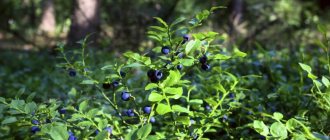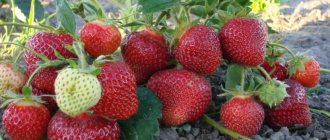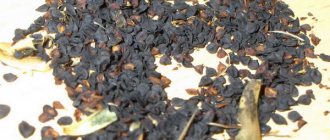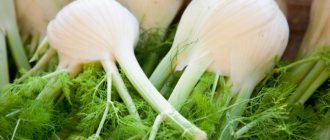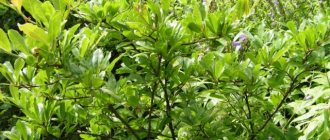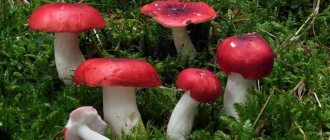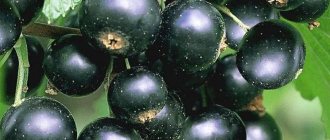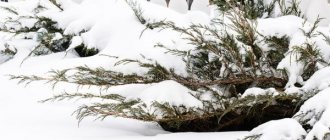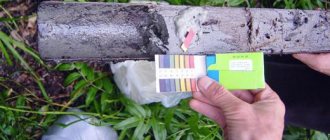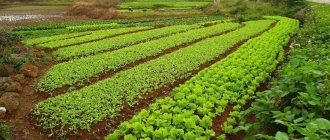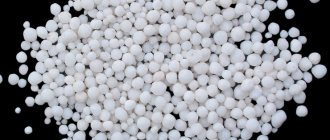Types and varieties of cranberries: winter-hardy swamp and heat-loving large-fruited
In the northern regions of Russia, many hectares of wetlands are occupied by vast wild thickets of swamp cranberries, which easily withstand harsh winters with frosts of forty degrees.
Swamp cranberry grows in abundance on the peat bogs of northern and central Russia
The breeding of cultural forms of this wonderful medicinal berry began only in the middle of the last century at the Kostroma Experimental Station, where several very successful, highly winter-hardy varieties with berries twice or three times larger than those of the original natural species were created. Some of them are not inferior in berry size to the best American varieties, significantly surpassing them in frost resistance.
The largest-fruited varieties of swamp cranberries (photo gallery)
The beauty of the north ripens at the end of September, the variety is characterized by high levels of disease resistance and frost resistance
Gift of Kostroma is characterized by high yield and large berries
Cranberry Severyanka is a medium-ripening variety that can withstand frosts down to -33 degrees
Comparative characteristics of large-fruited marsh cranberry varieties (table)
| Name | Berry size (g) | Productivity (kg/sq.m) | Berry coloring | Ripening period |
| Beauty of the North | 1,5 | 1,4 | Light red | Late |
| Gift of Kostroma | 1,9 | 1,0 | Dark red | Average |
| Severyanka | 1,1 | 0,9 |
Another type of cranberry grows in North America - the large-fruited cranberry, which differs from the European marsh cranberry in having denser berries, the presence of vertical fruit-bearing shoots, a longer growing season and less winter hardiness.
American cranberry differs from swamp cranberry in having denser berries.
It was introduced into culture much earlier, already at the beginning of the century before last. There are many varieties of it with large berries, the earliest and most winter-hardy of them can be grown in Russian conditions: from the Moscow region and further south.
Varieties of American large-fruited cranberries (photo gallery)
Ben Lear is an early ripening variety, suitable for cultivation throughout Russia
Cranberry Pilgrim is a late-ripening variety, berries of uneven color can be stored for a long time
Big Pearl cranberries have large berries, the variety is used for growing on an industrial scale
The Mac Farlin variety is characterized by high yield, the color of the berries is dark, almost black.
Cranberry Stevens produces a harvest in late September - early October; the berries can be stored for up to a year without processing
Hoves cranberry can withstand frost and direct sunlight
Comparative characteristics of American cranberry varieties (table)
| Name | Berry size (diameter, mm) | Productivity (kg/sq.m) | Berry coloring | Ripening period |
| Ben Lear | 18–22 | 1,6–2,0 | Maroon | Very early (late August - early September) |
| Pilgrim | 20–24 | 2,0–2,5 | Dark red | Medium (late September - early October) |
| Big Pearl | 18–20 | 1,5–2,0 | ||
| Mc Farlin, sometimes mistakenly spelled McFarlane | 16–24 | 1,4–2,0 | ||
| Stevens | 18–24 | 0,8–2,5 | ||
| Howes | 15–19 | 1,0–1,9 | Red | Late (October) |
Video: garden large-fruited cranberries
When to pick cranberries
Both large-fruited and swamp cranberries begin to bear fruit in the third year after planting the cuttings, but a full harvest occurs only in the fourth. The average yield of the most productive varieties is 1–1.5 kg/m2.
Cranberries can grow in one place for several decades.
Cranberries are harvested only when they are fully ripe - in late September - early October, or even in early spring. Berries left under the snow are sweeter and more pleasant to taste, however, they contain less vitamin C and are stored worse than those collected in the fall.
Unripe cranberries are tasteless, do not have bactericidal properties and quickly spoil.
Choosing the type and variety of cranberries for growing in the regions
- North and North-West Russia, the Urals, Siberia: here you can grow only domestic varieties of bog cranberries, which grow in huge quantities in the wild on the numerous peat bogs of this region. American large-fruited cranberries do not have enough summer heat here to ripen the berries.
- Central region of Russia (including the Moscow region), northern Belarus: all varieties of bog cranberries grow magnificently. In the most favorable years, the harvest of the earliest varieties of large-fruited cranberries is possible.
- Chernozem regions of Russia, southern Belarus, Ukraine: good conditions for all varieties of swamp cranberries, as well as for early varieties of large-fruited cranberries. The advancement of this crop to the south is limited by excessively high summer temperatures and dry air.
PILGRIM
PILGRIM
Plants grow slowly, shoots are usually densely spaced.
Late ripening variety. Ripens in early October. The vine is of medium height (usually forms a carpet 23 cm high) and is affected by snow mold. The variety is characterized by a yield of up to 1.4 kg/m2.
The berries are purple-red, oblong, with uneven coloring and a waxy yellowish coating, large, up to 25 mm and weighing up to 2.2 g. The pulp is dense, crisp, of high technological quality.
Berries are used in processed and fresh form. Stored well.
In what areas can cranberries be grown?
In the wild, cranberries grow exclusively in sphagnum bogs, which are a completely unique ecosystem with very specific characteristics:
In nature, cranberries grow only in high sphagnum bogs.
- High level of groundwater coming directly to the surface of the earth.
- Extremely high soil acidity (pH 3.0 – 5.5).
- The soil consists almost entirely of peat - a loose, permeable organic substrate formed from dead peat moss.
- Covering almost the entire surface of such a bog, living sphagnum peat moss is a strong natural antiseptic that prevents the development of putrefactive processes.
Sphagnum peat moss is a unique natural antiseptic, the basis of the sphagnum bog ecosystem.
Accordingly, the most suitable areas for cultivating garden cranberries will be areas on peat bogs. This is the only type of soil that does not require any special preparation for planting cranberries. You can immediately mark the beds and plant.
A peat bog with close groundwater is an ideal place for growing cranberries.
Heavy clay soils are completely unsuitable. In such areas, growing cranberries is possible only in artificial trenches filled with peat. In lowlands with clay soil, when constructing trenches, the necessary slope and drainage should be provided so that water does not accumulate after heavy rains or melting snow. Unlike permeable, “breathing” peat, waterlogged clay is like cement mortar; the roots suffocate and die.
Cranberries cannot grow on heavy clay - the roots will suffocate
Light sandy soils can only be considered suitable if daily watering is possible. They are well permeable to air and roots, but dry out too quickly. On sandy soils, a large amount of high-moor peat is required to increase moisture capacity and achieve the desired acidity. To better preserve moisture, it is advisable to line the planting trenches for cranberries with several layers of polyethylene film.
Sandy soils are easily permeable to roots but do not retain water at all.
Seasonal care features
After the bushes are planted, the care process begins. First of all, monitor the humidity level. The bed is watered at least twice a week at the rate of 10 liters per 1 m² of planting. On hot days, watering should be done more often, and on rainy days - less often. You shouldn’t over-water the soil—it’s enough to soak only the top layer. From mid-August, watering is reduced - the plant must prepare for winter.
The cuttings are fed for the first time after 15–20 days. Superphosphate (15 g per 1 m²) and potassium sulfate (7 g per 1 m²) are added to the soil. Nitrogen fertilizers are added in the spring, at the end of April and May. Top dressing per 1 m² should include:
- ammonium sulfate - 3–4 g;
- double superphosphate - 6 g;
- potassium sulfate - 3–4 g.
Since the shoot will be cultivated in one place for more than one year, it is recommended to monitor its cleanliness - weeds are removed as they appear. For the first 3 years, weeding and loosening the soil should be regular procedures. Weed the plantings 3-4 times per season. The work is carried out carefully, trying not to grab rooted seedlings. If the soil on the plantation settles, peat is simply added on top.
Important! Chicken droppings, manure, and compost cannot be used - they will ruin the plant due to excessive nitrogen content.
Cranberry plantations are periodically mulched with sand or peat chips: they provide favorable conditions for the development of the root system and the entire plant.
Sanding is done once every 2-3 years: work is carried out in early spring, before the crop begins to grow. Sand is scattered 2–3 cm thick throughout the plantation. Plantings with bushes older than three years must be mulched with peat chips every 3-4 years.
Where is the best place to place cranberries in the garden?
Cranberries need:
- loose, permeable, very acidic soil (pH 3.0 – 5.5);
- absence of weeds, especially perennial rhizomatous ones;
- good lighting;
- groundwater no further than half a meter from the surface of the earth (in extreme cases, it can be replaced by daily abundant watering).
Cranberries require very acidic soil (pH 3.0 – 5.5)
Compatibility of cranberries with other plants
Other plants from the heather family also have similar requirements for soil acidity as cranberries: lingonberries, blueberries, blueberries, crowberries, wild rosemary, and rhododendrons. The needs of cranberries, blueberries and crowberries are the closest; in nature, they often grow nearby on swamp hummocks, in well-lit places. In the same swamps wild rosemary grows, as well as berry herbaceous perennials from the Rosaceae family - cloudberries and princelings. Blueberries are also moisture-loving, but prefer shady forest areas. Lingonberries love drier places and good lighting; in nature they grow in fairly dry pine forests on sandy soils, so it is better not to plant them in the same bed with cranberries in the garden due to different watering regimes. Rhododendrons require good drainage; they cannot tolerate excess moisture. In natural communities, all these plants are companions of coniferous trees (spruces, pines, larches, common juniper). When planting them in the garden, it is also advisable to add a little soil from a coniferous forest with wild-growing heathers to ensure that the soil contains the necessary mycorrhiza - special underground fungi that promote root growth.
Companion plants for cranberries (photo gallery)
Lingonberries are small in size with a characteristic sour taste
Crowberry berries are covered with a tough skin.
Blueberries are used for medicinal purposes
Blueberries are consumed fresh and also used to make wine.
Cloudberry berries are used in therapeutic dietary nutrition
Cloudberry is a perennial herbaceous plant of the northern regions.
Princeberry berries look similar to raspberries
Knyazhenika is a tonic and quenches thirst well.
Wild rosemary is used in perfumery
Dahurian rhododendron is an evergreen shrub
You should not plant cranberries directly under the crown of a tree: firstly, they need good lighting, and secondly, the powerful roots of trees dry out the soil very much.
When choosing neighbors for cranberries, it is necessary to take into account that its long creeping shoots in good conditions quickly grow, covering the soil surface with a continuous green carpet.
In favorable conditions, cranberry thickets are very durable and remain in one place for many decades.
Green cranberries - beneficial properties
The beneficial properties of green cranberries are fully revealed if you observe the harvest time. It is not worth collecting it completely green, since the necessary vitamins and minerals have not yet formed in the required quantities. The earliest harvest time is late summer - early autumn. You should not pick cranberries before August 25 - such berries most likely will not ripen.
Early harvesting of berries allows you to increase their shelf life. The collected berries can be used to prepare various dishes. Pickled berries, pureed with sugar or frozen, are well stored. After any processing, cranberries almost do not lose their beneficial properties.
Cranberries are used as an antipyretic for colds. In addition, they perfectly strengthen the immune system and help with oral diseases.
Cranberries are indispensable for the gastrointestinal tract, as they improve digestion, normalize microflora and promote weight loss and normalize metabolism.
Cranberry is indicated for diseases of the lungs, liver and kidneys, as well as for the prevention of diseases of the cardiovascular system.
Cranberry regulates emotional state, improves the nervous system and promotes a good night's rest.
Cranberry care
The main problem when growing cranberries is maintaining the required soil acidity (pH 3.0 - 5.5). To control acidity, you need special litmus indicator paper, which is sold in garden centers and pet stores in the aquarium goods department. To find out the acidity, a small amount of soil is mixed with distilled water, a strip of indicator paper is immersed in this liquid and its color is compared with the control scale on the package.
Litmus indicator paper for determining the acidity of water and soil
Water for watering cranberries also needs to be controlled. Firstly, it must be sufficiently acidic, like the soil. To acidify water, you can use any acid, from vinegar essence to car battery electrolyte.
Safety precautions: always add a small amount of acid to a container with a large amount of water, and nothing else. Concentrated acids are dangerous and cause burns if they come into contact with the skin.
Secondly, the water should not be too hard. The most favorable is soft water from rain, melting snow, and from some natural lakes. Many wells and artesian springs have very hard water with a high lime content; such water is not suitable for watering cranberries.
Signs of hard water:
- The tea is poorly brewed and turns out cloudy and tasteless;
- Soap, shampoo, and washing powder do not foam well;
- ordinary soap immediately precipitates in flakes.
Cranberries should be watered regularly with soft acidic water, not allowing the soil to dry out. In areas with deep groundwater (further than half a meter from the soil surface), daily watering is required in hot weather.
Fertilizing cranberries
It is strictly unacceptable to apply manure, compost, bird droppings and other nitrogen-rich fertilizers under cranberries. The only organic matter that suits it well is peat. For the first year or two after planting, no fertilizers are required at all. In the future, only mineral fertilizers are applied in very small doses, only in spring and in the first half of summer (until mid-July). Approximate annual norm per 1 square meter (distributed in equal shares into 3 doses):
- 5 g urea,
- 15 g superphosphate,
- 10 g potassium sulfate.
Cranberries do not need any chemical treatments against pests and diseases.
Swamp cranberries overwinter well without additional shelter. Plantings of large-fruited cranberries can be slightly insulated with coniferous spruce branches.
On industrial plantations in regions without winter thaws, cranberries are sometimes frozen in ice for the winter. When persistent frosts below -5 ° C occur, the plantings are filled with water in a layer of 2–3 centimeters, and after it freezes, repeat so that the plants are completely covered in the ice. In spring, excess water is discharged into the drainage system.
During the flowering period, which begins in the first half of June, cranberries may suffer from frost. For protection, flowering plantations are covered with agrofibre or plastic film at night. During the day, the shelter is removed.
During the flowering period, cranberries need protection from frost.
ROOFING
ROOFING
A mid-early variety with a rather extended ripening period.
The berries are round-oval, red or dark red, weighing 1.8 g, suitable for storage. Winter hardiness is average. Productivity up to 0.9 kg per 1 m2.
The berries are consumed fresh or processed. The berries are widely used in the treatment of diseases of the kidneys, stomach, urinary tract, intestines, and vitamin deficiencies.
Cranberry propagation
Cranberries propagate vegetatively (by cuttings) and by seeds.
Propagation of cranberries by green cuttings
This is the easiest way. In June, cuttings about 10 centimeters long should be cut from young growing shoots and planted on a peat bed, leaving no more than 2-3 leaves above the surface. Water daily, not allowing the soil to dry out. Can be covered with film to maintain humidity. You can plant it immediately in a permanent place, 2-3 cuttings per hole. Over the summer, the cuttings take root successfully.
The easiest way to propagate cranberries is by rooting green cuttings
Cranberry propagation by seeds
In the absence of ready-made seedlings or cuttings, cranberries can also be grown from seeds. Varietal characteristics are rarely preserved during seed propagation, but plants grown from seeds are better adapted to local climatic conditions.
The procedure is as follows:
- Prepare a shallow pot filled with a damp mixture of high-moor peat with a small addition of river sand.
- Spread cranberry seeds on the surface of the soil.
- Sprinkle with a thin layer (1 millimeter) of river sand.
- Water carefully.
- Cover the pot with plastic wrap.
- Place in the refrigerator for stratification at a temperature of +3–5 °C.
- Leave there for 2–3 months, ventilating daily and watering if necessary, so that the soil is slightly moist all the time.
- After stratification is completed, move the pot to a room with a temperature of +15–20 °C, continuing to water regularly.
- Over the next 2–4 weeks, shoots will appear.
- After several true leaves appear, plant the seedlings in separate pots with a peat mixture.
- In the second half of June, plant the plants in open ground on a peat bed.
SEARLES
SEARLES
The plants have brown stems.
Ripens in mid-September.
Ripe berries are red without gloss, large, speckled, with a maximum length of up to 22 mm. Productivity 13-15 t/ha. Aligned in shape, oblong.
Keeping quality is satisfactory. It is recommended to use the berries fresh and processed.
Botanical description and characteristics
Lingonberries belong to the Heather family. It looks like a small bush 8–25 cm high. Sometimes bushes reach 1 meter if some kind of obstacle arises in their path. The roots of the plant are creeping, horizontal, with shoots whose height reaches up to 20 cm.
Lingonberry is called an evergreen plant because its leaves do not change color. They are smooth, leathery, curved downwards along the edges, up to 3 cm long and up to 1.5 cm wide, overwinter under the snow. The upper surface is dark green, the lower is lighter and dotted with chiseled glands (hairs) that absorb water.
The plant begins to bloom quite late - at the end of spring. Withstands frosts down to -30 degrees. Lingonberry berries are dark red, spherical, shiny, up to 8 mm in diameter, weigh up to 0.5 g, and contain many brown semi-lunar seeds (from 5 to 30). The taste of the berries is sweet and sour.
They begin to ripen in late summer or early autumn. Freezing makes the berries more watery and soft. In the wild, the berry yield is only 100 g per 1 m². New varieties of garden lingonberries produce about 2 kg of berries per 1 m² for the entire season.
Important! Berries that have overwintered immediately fall off and become unsuitable for transportation.
Properties of lingonberries: harm and benefits
Useful properties of lingonberries
It has been known for a very long time that lingonberry fruits have healing properties. So, it used to be called the “berry of immortality” because it could cure many diseases. The main value of lingonberries is that they contain a large amount of vitamins A, E, B and C. The berries also contain organic acids (citric, malic, oxalic, benzoic and salicylic), minerals such as manganese, magnesium, potassium, iron, calcium and phosphorus, as well as starch, mono- and disaccharides, flavonoids and other substances that the human body needs.
The foliage of this plant is not inferior to its fruits in terms of healing properties.
It also contains many useful substances, and the most important of them is arbutin (a natural antiseptic). Today, fruits are used for medicinal purposes somewhat less frequently than foliage.
The fact is that leaves are much easier to harvest and transport, and they can be stored for a longer time without losing their beneficial properties. The foliage has anthelmintic, wound-healing, antiscorbutic, diuretic, diuretic, restorative, antipyretic, tonic, laxative, choleretic and antiseptic effects.
This plant is recommended for use in the treatment of coronary heart disease, since its fruits contain copper, chromium and mineral salts. Lingonberries are also recommended for people with high blood sugar because they help lower glucose levels. If a woman experiences anemia or neurosis during pregnancy, they are recommended to take the juice of this plant. With low stomach acidity, such fruits help normalize intestinal motility.
A decoction made from the leaves is used for kidney diseases, rheumatism, diabetes and gout, and a decoction of the berries helps quench thirst during fever. In order to eliminate fatigue and restore strength, you can use lingonberry tea; to prepare it you just need to brew the leaves with boiling water. This plant enhances the effect of antibiotics and sulfa drugs; therefore, lingonberry juice is recommended for fever and to improve appetite after a long, serious illness.
Why are lingonberries so useful?! The benefits and harms of lingonberries for the body
Watch this video on YouTube
Contraindications
Lingonberry leaves should not be used by people with high acidity of gastric juice, as well as by children under 12 years of age.
Hypotonics use remedies from the foliage with extreme caution, and they cannot be used for longer than 15–20 days, then the body must be given a rest for half a month. The fact is that such drugs have a powerful diuretic effect, which is why there is a high probability of a sharp drop in blood pressure
The fruits should not be consumed by people with stomach ulcers or gastritis with high acidity. Also, they should not be used for internal bleeding and postoperative patients, because they have a powerful thinning effect.
It should be remembered that lingonberries can accumulate toxins and radioactive substances; therefore, fruits growing near a cemetery, highway or industrial production should not be consumed.
Cranberry pests and their control
Cranberries can be affected by more than 40 pests that feed on its ground organs. Most often found on cranberries:
- black-headed lingonberry leafroller;
- apple comma scale;
- gypsy moth;
- cabbage scoop;
- heather moth.
Pests are not able to cause significant damage to cranberries, therefore, protective measures can be limited to compliance with agrotechnical rules for cultivating the crop, and first of all, it is necessary to pay attention to the regular control of weeds that inhibit cranberries and create favorable conditions for harmful insects. Insecticides (Aktara, Aktellik, Karbofos, Metafos and others) should be used only in cases of extreme necessity and no later than a month before harvest, as well as after picking the berries.
Description
Cranberries belong to the Veres family. It grows in the form of evergreen shrubs. The branches of the plant are creeping, thinly thread-like, rooting.
In the wild, this berry - Swamp cranberry (in Latin, Ochusosсus palustris) grows in swamps (upland, transitional), along the marshy banks of reservoirs or in sphagnum coniferous coppices and forests. The distribution area of cranberries is the temperate zone of the entire Northern Hemisphere of the planet. The plant is especially common in the forest belt of tundra and forest-tundra of Asia, Europe, and North America.
Photo of cranberries collected in a swamp
The first time cranberries were grown was in 1816 by an American (from Massachusetts) Henry Hall - he created a small, rather primitive plantation. The berry was first planted on an industrial scale near Boston in 1983. Since then, breeders have created more than 200 varieties of cranberries, but for industrial purposes, garden cranberries are most often grown - large-fruited cranberries (American). In the USA, Ukraine, Belarus and many other countries, this shrub is called “crane berry”, “crane berry”: with berries it is very similar to a crane with its head bowed on a thin neck.
In the photo - garden cranberry
Cranberry diseases and their treatment
Compliance with agricultural techniques will allow you to maintain the health of cranberries at the proper level, but sometimes annoying troubles still happen, and some kind of ailment can affect a healthy cranberry. In such a situation, it is important not to get confused and immediately begin to fight the disease before it affects all the plants, and for this you need to accurately determine the nature of the disease. So, what is wrong with cranberries?
Snow mold is the most harmful disease, which develops from March to April. Symptoms of the disease are a red-brown color of cranberry buds and leaves, on which yellowish mycelium can be seen. By the end of spring, the affected leaves become ashen in color and fall off. If the disease is not dealt with, the lesions increase in size, merge, and the entire plant may die.
Control measures. In the fall, the area is sprayed with a solution of Fundazol in accordance with the instructions, and in the winter, the area is gradually filled with water and frozen in layers.
Red spot is also a fungal disease that deforms shoots and causes them to die. In addition to shoots, red spotting affects cranberry flowers, buds and pedicels, which acquire a pinkish tint. The leaves developing from the affected buds look like small roses.
Control measures. To destroy pathogens, cranberries are treated with a solution of 2 g of Fundazol or Topsin M in 1 liter of water.
- Kobeya: growing from seeds, types and varieties
Monilial burn is a fungal disease that causes the tops of shoots to wither, turn brown and dry out. In humid weather, the affected area turns yellow, and the cranberry becomes covered with a coating of conidial sporulation. At the bud formation stage, the infection passes from diseased shoots to buds, flowers and ovaries, causing the flowers and buds to dry out, and the diseased ovaries continue to develop, preparing a surprise for you in the form of rotting fruits.
Control measures. In the fight against moniliosis, the fungicides Topsin M, Ronilan, Ditan, Bayleton and copper oxychloride have proven themselves well.
Phomopsis is a disease that causes drying of the ends of cranberry shoots without signs of wilting. The leaves first turn yellow, then turn orange or bronze, but do not fall off. The stems become covered with dirty gray spots that turn into cankers. Flowers and fruits turn brown. The disease progresses in dry and hot weather.
Control measures. To destroy the primary infection in the spring, cranberries are treated with Topsin M or another systemic fungicide. Before active growth begins, spraying cranberries with Bordeaux mixture is effective.
Cytosporosis is a black rot of cranberries, the pathogens of which penetrate at the end of summer through small wounds on the plant.
Control measures. Treatment of cranberries for black rot - preventive treatments at the beginning and end of the season with Bordeaux mixture, Topsin M or copper oxychloride.
Gibber spot is dangerous because it causes massive premature leaf fall, which greatly weakens the plant. In early August, small red-brown spots appear on the leaves, then shapeless and chlorotic spots with a dark rim and fruiting bodies in the center.
Control measures. Hiberra is destroyed by treating cranberries with a solution of 2 g of fungicide (Topsin M, Fundazol, copper oxychloride) in 1 liter of water.
Pestalocia affects the fruits, stems and leaves of cranberries. First, dark brown spots appear on the greenery, then outlined by a dark border and gray spots merging with each other. Young shoots bend in a zigzag manner and dry out, the leaves fall off.
Control measures. Treating cranberries with copper oxychloride will help cope with the disease.
Ascochyta blight can be recognized by round dark brown spots on the leaves and stems of cranberries. As the disease progresses, the surface underneath these spots cracks.
Control measures. An effective remedy for ascochyta blight is treating cranberries in spring and autumn with fungicides - Fundazol, Topsin M, copper oxychloride.
Botrytis - this disease, which covers the stems, leaves and flowers of cranberries with a gray fluffy coating of fungus in wet weather, does not affect young shoots. Another name for the disease is gray rot.
Control measures. Treat cranberries with Bordeaux mixture, Topsin M or copper oxychloride.
Cranberry blight, or sprouting, is a viral disease caused by mycoplasma organisms. The affected parts become like “witches' brooms” - the shoots rise, the leaves become smaller and fit tightly to the shoots. Cranberries affected by growth do not bear fruit, and those ovaries that had already formed before the onset of the disease produce small, ugly fruits.
Control measures. How to spray cranberries to destroy growth pathogens? Such drugs have not yet been invented, so you just need to remove the diseased plant from the garden and burn it so that the disease does not spread throughout the garden.
